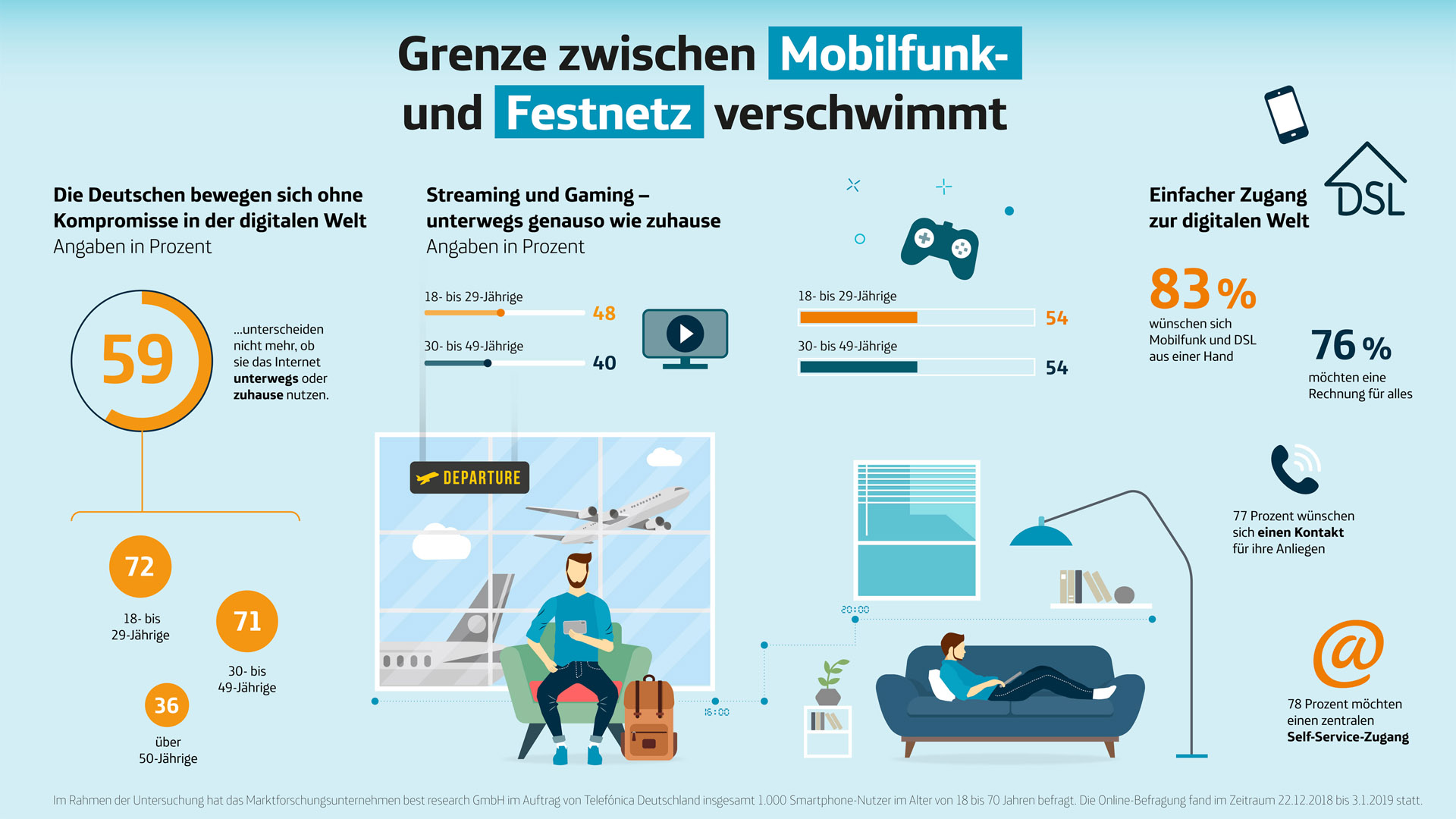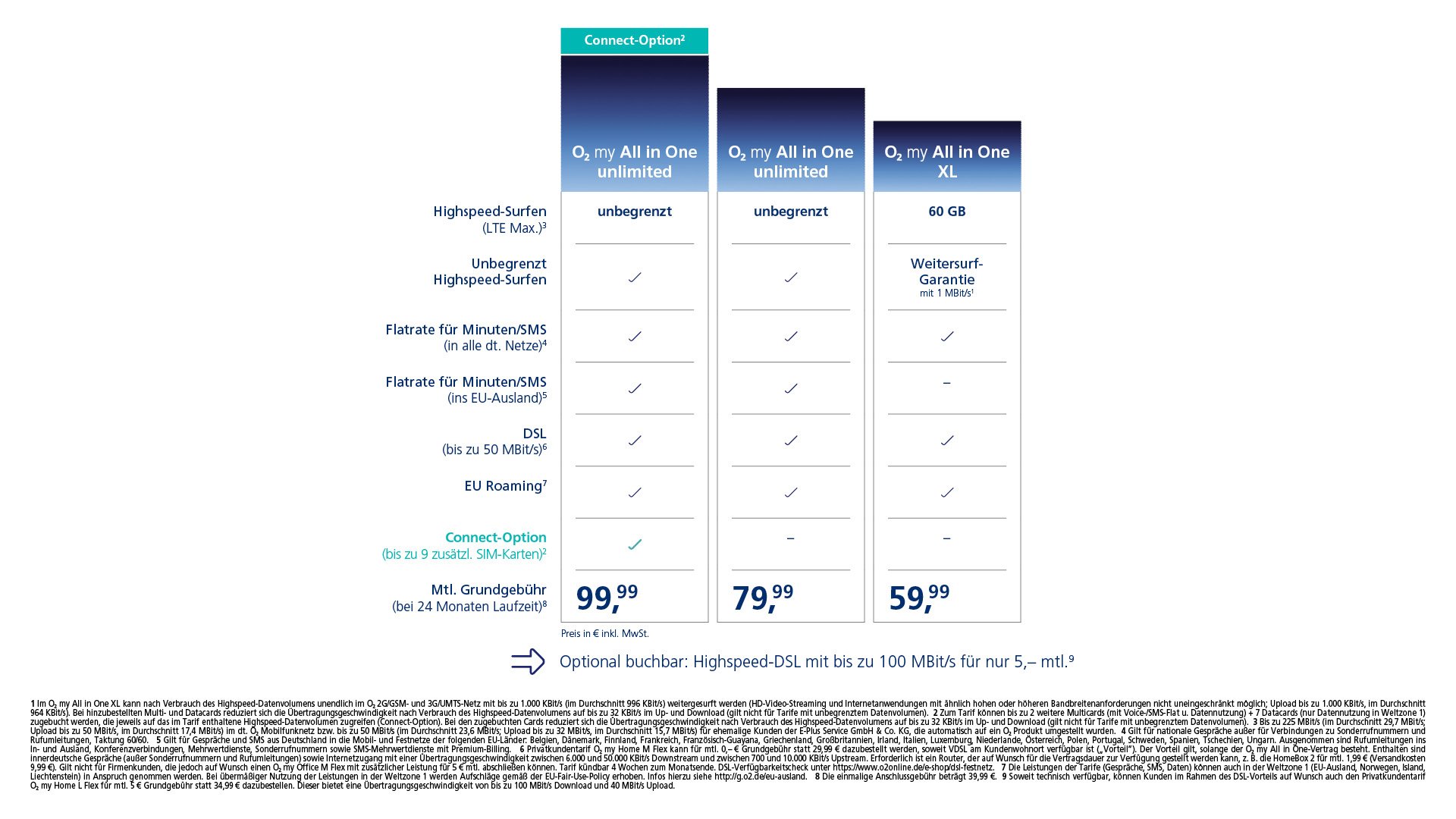22.01.2019
Exclusive study on Internet use:
The boundaries between mobile and fixed services are becoming increasingly blurred

Study results (in German)
Germans surf in the same way on the move as at home: Six out of ten consumers no longer distinguish whether they use the Internet while mobile or in their own home – they move without compromise in the digital world, anywhere, any time. That is the result of a representative study conducted by Telefónica Deutschland.1)
For as much as 72% of the 18- to 29-year-olds surveyed, it is irrelevant today whether they use the Internet while on the go or at home – it does not affect their Internet usage. For 30- to 49-year-olds, it is 71%. This is possible on the one hand thanks to modern smartphones, tablets and wearables with a variety of applications. On the other hand, it is because the LTE expansion is making progress continuously and mobile high-speed surfing is a key driving force of digitalisation. And finally, tariffs with high data allowances such as O2 Free Boost or convergent offers such as O2 my All in One give customers the opportunity to take advantage of digitalisation without compromise. The idea that stationary Internet is cheap and mobile Internet is expensive has been outdated for a long time and is vanishing from peoples’ minds.
- Clear trend: The boundaries between mobile and fixed services are blurring
- Any time and anywhere: Today, customers use the Internet in the same way on the go as at home
- Streaming, gaming, sharing: No longer just via DSL but also via LTE
- Everything from a single provider: Users want easy access to the digital world
- Simplicity through convergent package: O2 offers mobile, fixed and Internet services in one tariff
Streaming, gaming, sharing: both on the move and at home

Photo: Getty Images
This is particularly evident when streaming videos or TV programmes. In your home or on the go: Almost half of the 18- to 29-year-olds stream their favourite series or the latest blockbuster from anywhere. This applies to four out of ten of those surveyed aged 30 to 49. Six out of ten of those surveyed (62%) said they find it enriching that they no longer have to think about when or where they are when streaming. This applies to as much as 82% of those surveyed aged between 18 and 29 and 71% of those aged between 30 and 49.
Even popular online games such as Fortnite and the like are now no longer only played on the PC at home. More than half of the 18- to 29-year-olds and the 30- to 49-year-olds surveyed game on the move (both 54%), although a large high-speed data volume is needed for this. A lot of data is also used by cloud services, for example. Nevertheless, five out of ten of those surveyed store files on the World Wide Web and download them from there.
The results of the study make it clear that it is not just young people who are taking advantage of digitalisation opportunities – no matter where or when. The 30- to 49-year-old age group does not distinguish whether they surf via DSL or LTE. And this trend continues in the over-50s, for example, when using messaging services (67%) or when sending and sharing pictures and videos (64%).
Consumers want easy access to the digital world

Photo: Getty Images
It is important for most users of telecommunications users to make their access to the digital world as easy and convenient as possible. That means: mobile, fixed and Internet services from a single provider. One tariff, one bill, one service contact. In the survey, all age groups indicated that they found it easier to just take care of one contract for mobile, fixed and Internet services (83%). In particular for young people (up to 29 years old), easy access to the Internet and telephone is crucial (91%). It is still 79% for the 30- to 49-year-olds and even 81% for those over 50.
It is almost just as important to all those surveyed to receive only one bill for all telecommunications services (76%). The same goes for service: 77% of users appreciate having one contact person for all telecom issues instead of having to contact different providers for mobile, fixed and Internet services. Today, the self-service approach is no longer important to only young people: 81% of 18- to 29-year-olds find it helpful to have central access to self-service and therefore have to remember only one password. This is 80% for those aged between 30 and 49 and 72% for the over 50s.
O2 has a tariff for everything

O2 my All In One tariff portfolio (in German)
Since August 2018, the O2 brand has had a real convergent package in its portfolio: The unlimited tariff O2 my All in One applies for both mobile and fixed services. On 5 February 2019, O2 is launching another combination product: For mobile surfing, O2 my All in One XL includes a high-speed LTE data volume of 60 GB. If this has been used up, customers can continue surfing without interruption at up to 1 Mbit/s thanks to the O2 keep-surfing guarantee.2) The tariff also includes a full VDSL connection, allowing users to surf at home with unlimited volume and a download speed of either 50 or 100 Mbit/s.3) All O2 my All in One customers receive one bill for mobile and fixed services and central access to their personal “my O2” self-service area. All contractual data can be seen at a glance and can be modified if necessary.
| 1) | As part of the study, market research company best research GmbH surveyed a total of 1,000 smartphone users aged 18 to 70 on behalf of Telefónica Deutschland. The online survey was conducted between 22 December 2018 and 3 January 2019. |
| 2) | After the high-speed data volume has been used up, continued uninterrupted surfing is possible in the O2 2G/GSM and 3G/UMTS network at up to 1000 kbit/s (on average 996 kbit/s) (HD video streaming and Internet applications with similarly high or higher bandwidth requirements are not possible without limitations; upload up to 1,000 kbit/s, on average 964 kbit/s). In terms of the multi and datacards added, the transmission speed after the high-speed data volume has been used up is decreased to up to 32 kbit/s in the upload and download (this does not apply to tariffs with unlimited data volume). |
| 3) | Retail customer tariff O2 my Home M Flex can be added on for EUR 0 basis fee instead of EUR 29.99 if VDSL is available at the customer location (“advantage”). The advantage applies if there is a O2 my All in One contract. Calls within Germany (except special rate numbers and call diversions) and internet access with a transmission speed between 6,000 and 50,000 kbit/s downstream and between 700 and 10,000 kbit/s upstream are included. A router is required, which can be provided for the contract period upon request, e.g. HomeBox 2 for EUR 1.99/month (shipping cost EUR 9.99). This does not apply to corporate customers, but on request, O2 my Office M Flex can be concluded with additional performance for EUR 5/month. The tariff can be cancelled at the end of the month with 4 weeks’ notice. DSL availability check https://www.o2online.de/e-shop/dsl-festnetz Customers, who attach importance to higher surfing speeds choose O2 my Home L Flex for an extra EUR 5/month. |